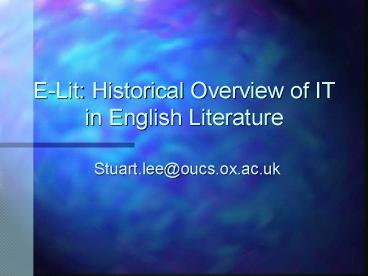E-Lit: Historical Overview of IT in English Literature - PowerPoint PPT Presentation
Title:
E-Lit: Historical Overview of IT in English Literature
Description:
... Historical Overview of IT in English Literature Initial points Aim of course Aim of Class IT and English Literature Analysis of Resources Access to ... – PowerPoint PPT presentation
Number of Views:115
Avg rating:3.0/5.0
Title: E-Lit: Historical Overview of IT in English Literature
1
E-Lit Historical Overview of IT in English
Literature
- Stuart.lee_at_oucs.ox.ac.uk
2
Initial points
- Course and assessment - LOG ON
- Web site (http//www.english.ox.ac.uk/ gt On-line
course material gt E-Lit gtCourse site) - Bulletin Board
- Using the room
- Final assessment - save in B drive
- Guest lectures, OUP visit
3
Aim of course
- The impact of the new technologies on English
literature and language - Changes in the world of publishing
- The history of computer-based English literature
projects - Transferable skills
4
Aim of Class
- Look at the main areas where IT has been used in
English literary studies - Hands-on analysis of a few selected packages
- Discussion of common themes gt esp. design and
content
5
IT and English Literature
- Analysis of resources (textual)
- Access to resources
- Bringing together material to further the study
of the text, author, genre - Promoting dialogue
- Didactic/instructional
- Creative writing
6
Analysis of Resources
- Computers can handle large quantities of data
- In literature this usually relates to collections
of texts or corpora - Analysis (in theory) can provide a deeper
understanding of the text - Patterns, use of vocabulary (authorship studies),
development of themes, creation of indices and
concordances, etc. - Concordance of the Vulgate in the Middle Ages
- Fr. Roberta Busas analysis of St Aquinass texts
in 1946 - Covered in class 4
7
Access to Resources
- Primary material - electronic versions of texts
and mss - started with Project Gutenberg (early
1971), the Oxford Text Archive (1976),
Chadwyck-Healey began in early 1990s, finally
e-books (class 6) first manuscripts were
produced at Oxford and the BL - Secondary (editions, journals, monographs, etc.)
and reference material (dictionaries, companions,
encyclopaedias)
8
OED Case Study (p. 65)
- 2nd ed. Published on CD-ROM mid 1990s
- Allowed for non-standard searches of the
dictionary - Migrated to Web version end of 1990s
- Available under OxLIP
9
Hypertext publications
- Allowed literary scholars to bring together
material related to a specific text or author - Mixed media was available (text, images, audio,
and video) plus linking to stress intertextuality - The Web uses the same metaphors
- Hypertext discussed more in Class 3
10
Case study The Beowulf Workstation
- Written in HyperCard in 1991 by Prof. Patrick
Conner (West Virgina University) - Text of Beowulf plus tools to help students
translate and study the work - No longer runs but its design was highly
influential
11
(No Transcript)
12
(No Transcript)
13
(No Transcript)
14
Instructional/Didactic
- Rarely used as there as Literary studies tend to
be more discursive, with more emphasis on
research, analysis, argument - Yet is applicable in some areas where self-paced
learning and assessment is appropriate
15
Case Study STELLA (p.66)
- Software for Teaching English Language and
Literature and its Assessment (University of
Glasgow) - Series of self-paced modules with tests Scottish
Literature, Older Scots, English Metre, English
Grammar, Old English, Piers Plowman
16
(No Transcript)
17
(No Transcript)
18
Hands-on Analysis
- Content - what is available?
- Functionality - what does the package allow you
to do that is new? - Appeal - how easy is it to use, and how
aesthetically pleasing? - Commonality - what are the common technical,
design, and content features?
19
Discussion
- What did they contain?
- Structural design - tree diagram
- Authority, Purpose, Content, Accuracy,
Objectivity, Currency, Design - Greethams model editions
- All author or context-oriented?
20
Weeks activities
- Internet for English tutorial
- Look at web sites and post brief evaluation on
the bulletin board (one or two paragraphs) - Reading for Class 1 and Condron (pp. 15-18)































